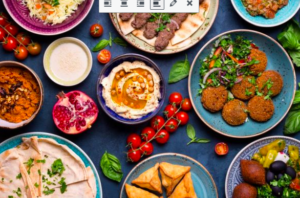The Art of Arab Cooking

By: Nouha Elyazidi / Arab America Contributing Writer
Arab cuisine is renowned globally for its phenomenal taste and exceptional flavors. From couscous in Morocco to mansaf in the Levant. Arab cuisine has become somewhat popular in the Western world, and you can find plenty of recipes and tons of different dishes from cookbooks to YouTube videos. But before we can begin cooking, one of the most essential things to learn about Arab cooking is the art behind it.
The primary thing to note is that most Arabs do not use concrete measurements for cooking. Arab cooking involves developing a sense of what it is that you are cooking. Most people will have guidelines, like a pinch of salt or a handful of parsley, but for the most part, Arabs will use the amount that “feels right.” This is very difficult for beginners and will take practice, but eventually, you will develop a better sense of what you need to add to your food and the right amount of what you need.
The word “maklouba/مقلوبة” translates to “flipped.” This is significant because a lot of Arab cooking involves flipping. A very famous dish that originates in the Levant region is called maklouba. It is made with rice, meat, and vegetables in a large pot, The pot is then flipped upside down and the dish beautifully falls onto the plate. Flipping is no easy task and something you might want to practice a little before making maklouba or any other dish that needs to be flipped.
It is very normal for Arabs to serve more than one course at a gathering. In fact, it is the norm in many countries to serve guests many main courses on top of appetizers, desserts, and tea. Preparing Arab feasts is a very time-consuming and daunting task, for not only are you making a large quantity, but the preparation of traditional Arab dishes can also be time-consuming. My advice to beginners would be to start out making smaller quantities first, really experiment with the dish, then progress on larger quantities.
Tied into extravagance is presentation. Arabs can get creative when it comes to how their dishes are presented. The people of Morocco have a saying, “ العين تأكل قبل المعدة” which translates to “The eye eats before the stomach.” And this is very reflective of the importance food presentation has in the Arab world! Arabs get very creative, using spices as garnishes, cutting up other foods creatively, and using only the finest china for serving.
Another very important element in the art of Arab cooking is the staples used in Arab cooking. Every Arab country and region has culinary staples, but there are a few things you are bound to find in every Arab kitchen. The first would be olive oil! From a garnish on hummus to the base of tagines, the olive oil industry is booming in the Arab world and it is reflected in the kitchen. Chickpeas are another very important aspect, they are nutritious and used in classics like hummus, hariria, and couscous. Another food that is featured in almost every Arab dish is some element of grains/rice. The type of rice and grain vary from region to region and dish to dish, but the Maghreb region is known for pairing bread with a significant amount of their cuisine, and in the Middle East dishes such as chicken machboos, kabsa, and mansaf have a rice base. The last thing I will mention is orange and rose blossom water. Primarily used for sweets, these waters are used in basboosa, cakes, cookies, and more.
Now, you are better equipped for your journey in the art of Arab cooking. Do not let this list overwhelm you! Arab cooking can sometimes be a little intimidating because of the details and intricacy but do not let that discourage you because cooking is not about getting every single detail perfect, it is about appreciating the culture and enjoying something great!
Check out our blog here!








